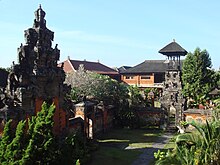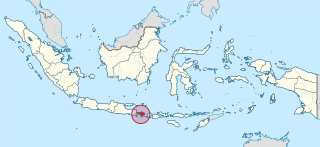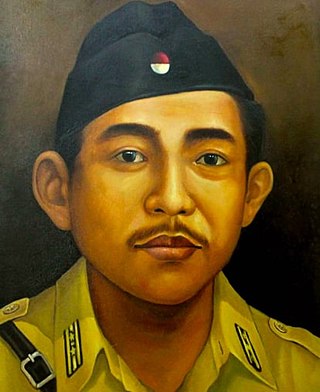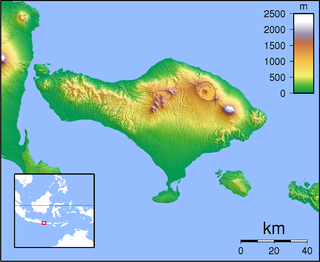 Frontview | |
| Established | 1931 |
|---|---|
| Location | Denpasar |
| Coordinates | 8°39′27″S115°13′6.7″E / 8.65750°S 115.218528°E |
The Bali Museum is a museum of art and history located in Denpasar, Bali, Indonesia.
Contents

 Frontview | |
| Established | 1931 |
|---|---|
| Location | Denpasar |
| Coordinates | 8°39′27″S115°13′6.7″E / 8.65750°S 115.218528°E |
The Bali Museum is a museum of art and history located in Denpasar, Bali, Indonesia.

The museum was built in 1931 by architect P.J. Moojen, near the location of the former royal palace of Denpasar, which had been burnt to the ground during the Dutch intervention in Bali (1906), and used it as a model for its outside walls and courtyards. [1]
There are four main buildings inside the museum, Tabanan displaying theatrical masks and musical instruments, Karangasem sculptures and paintings, Buleleng textiles, and Timur with archeological finds. [1]
It is located on the east side of the central square of Denpasar, Taman Puputan. [1]

Bali is a province of Indonesia and the westernmost of the Lesser Sunda Islands. East of Java and west of Lombok, the province includes the island of Bali and a few smaller offshore islands, notably Nusa Penida, Nusa Lembongan, and Nusa Ceningan to the southeast. The provincial capital, Denpasar, is the most populous city in the Lesser Sunda Islands and the second-largest, after Makassar, in Eastern Indonesia. The upland town of Ubud in Greater Denpasar is considered Bali's cultural centre. The province is Indonesia's main tourist destination, with a significant rise in tourism since the 1980s. Tourism-related business makes up 80% of its economy.

Denpasar is the capital city of the province of Bali, Indonesia. Denpasar is the main gateway to the Bali island, the city is also a hub for other cities in the Lesser Sunda Islands.

Ubud is a town on the Indonesian island of Bali in Ubud District, located amongst rice paddies and steep ravines in the central foothills of the Gianyar regency. Promoted as an arts and culture centre, it has developed a large tourism industry. It forms a northern part of the Greater Denpasar metropolitan area.

Bima is a city on the eastern coast of the island of Sumbawa in central Indonesia's province of West Nusa Tenggara. It is the largest city on the island of Sumbawa, with a population of 142,443 at the 2010 census and 155,140 at the 2020 census; the official estimate as at mid-2022 was 157,362. It is separate from the adjoining Regency of Bima which had a population of 520,444 according to the mid-2021 official estimates.

Danghyang Nirartha, also known as Pedanda Shakti Wawu Rauh, was a Shaivite religious figure in Bali and a Hindu traveler during the 16th century. He was the founder of the Shaivite priesthood in Bali.

Sanur is a coastal stretch of beach east of Denpasar in southeast Bali, which has grown into a little town in its own right. A 5.1 km (3.2 mi) area of Sanur's coastline, from Matahari Terbit Beach to Mertasari Beach, was reclaimed in 2008.

Puputan is a Balinese term for a mass ritual suicide in preference to facing the humiliation of surrender. It originally seems to have meant a last desperate attack against a numerically superior enemy. Notable puputans in the history of Bali occurred in 1906 and 1908, when the Balinese were being subjugated by the Dutch.

Colonel I Gusti Ngurah Rai was an Indonesian National Hero who commanded Indonesian forces in Bali against the Dutch during the Indonesian War of Independence. He was killed in the Battle of Margarana.
Gelgel is a village (desa) in the regency (kabupaten) of Klungkung, on Bali, Indonesia. The village, near the coast four kilometers south of the regency capital Semarapura, contains some structures of cultural interest and is known for its pottery and handwoven ceremonial songket cloth. The height of the village's power came during the kingdom of Gelgel, which dominated Bali from around the early 16th century to 1686. There are no traces left today of the old royal palace (puri). The old ancestral shrine of the ruling dynasty, Pura Jero Agung, is still standing in the old palace area. To the east of Pura Jero Agung is another old temple, Pura Dasar, which is a lowland counterpart of the "mother temple" of Bali, Pura Besakih. The village also contains the oldest mosque in Bali, which was built by Javanese retainers of the old kings.

Wijnand Otto Jan Nieuwenkamp, was a Dutch multi-faceted autodidact. As an artist he was active as a painter, draftsman, sculptor, etcher, lithographer, and designer of book covers and of ex-libris. In addition, he was also known as a writer, architect, explorer, ethnologist and collector of East Asian art.

The Dutch conquest of South Bali in 1906 was a Dutch military intervention in Bali as part of the Dutch colonial conquest of the Indonesian islands, killing an estimated 1,000 people. It was part of the final takeover of the Netherlands East-Indies. The campaign led to the deaths of the Balinese rulers of Badung and Tabanan kingdoms, their wives and children and followers. This conquest weakened the remaining independent kingdoms of Klungkung and Bangli, leading to their invasion two years later. It was the sixth Dutch military intervention in Bali.

The History of Bali covers a period from the Paleolithic to the present, and is characterized by migrations of people and cultures from other parts of Asia. In the 16th century, the history of Bali started to be marked by Western influence with the arrival of Europeans, to become, after a long and difficult colonial period under the Dutch, an example of the preservation of traditional cultures and a key tourist destination.

Dalem Segening was a king of Bali who reigned in the first half of the 17th century, his exact dating being still uncertain. He belonged to a dynasty which originated from Majapahit on Java, and ruled from the palace (puri) of Gelgel.

I Gusti Ketut Pudja was an Indonesian politician and national hero, who served as the first governor of Lesser Sunda from 1945 until 1946. He was a member of the Investigating Agency for Preparatory Work for Indonesian Independence (BPUPK). He was also present at Admiral Tadashi Maeda's house, during the preparation for the Proclamation of Indonesian Independence on 17 August 1945. Making him the only Balinese to be present during the proclamation.

The Kingdomship of Bali was a series of Hindu-Buddhist kingdoms that once ruled some parts of the volcanic island of Bali, in Lesser Sunda Islands, Indonesia. With a history of native Balinese kingship spanning from the early 10th to early 20th centuries, Balinese kingdoms demonstrated sophisticated Balinese court culture where native elements of spirit and ancestral reverence combined with Hindu influences – adopted from India through ancient Java intermediary – flourished, enriched and shaped Balinese culture.
The 1979 Bali earthquake occurred at 03:58 local time on 18 December with a surface wave magnitude of 6.3. The shock occurred southeast of the coast of Karangasem Regency in the Lombok Strait, and about 60 kilometres (37 mi) east-northeast of Denpasar. Up to 80 percent of the buildings in Karangasem Regency were damaged, between 15,000 and 500,000 people were displaced, and road links to the provincial capital of Denpasar were briefly severed.

I Gusti Ngurah Rai International Airport, also known as Denpasar International Airport, is the main international airport of Bali, Indonesia, located 13 kilometres (8.1 mi) from Downtown Denpasar, serves the Denpasar metropolitan area and the Bali island. Ngurah Rai is the second busiest airport in Indonesia after Soekarno-Hatta, Ngurah Rai is one of the most popular island destination hubs in Asia. In 2018, the airport served 23,779,178 passengers. The new upgrades of Ngurah Rai has increased the popularity of Bali and has become one of the best airports in Asia and being more known worldwide. The airport has category IX and is capable of serving wide-body aircraft including the Boeing 747-8 and Airbus A380.

Tegenungan Waterfall is a waterfall in Bali, Indonesia. It is located at the village of Tegenungan Kemenuh, also known as Kemenuh Village on the Petanu River in the Gianyar Regency, north from the capital Denpasar and close to the Balinese artist village of Ubud. The waterfall is isolated but has become a popular tourist attraction. It is one of the few waterfalls in Bali that is not situated in highlands or mountainous territory. The amount and clarity of the water at the site depend on rainfall but it contains green surroundings with fresh water that can be swum in. The waterfall includes varying highs that can be climbed after the descent down stairs to reach it. This attraction also features a viewing point to the jungle and waterfall at the main entrance.

Pura Maospahit is a Balinese Hindu temple or pura located in Denpasar, Bali. The pura is known for its bare red brick architecture, reminiscent of the architecture of the 13th-century Majapahit Kingdom, hence the name. Pura Maospahit is the only pura in Bali which was built using a concept known as Panca Mandala where the most sacred area is situated at the center instead of at the direction of the mountain.
The 2021 Bali earthquake struck at 04:18 local time (UTC+08:00) when people were still sleeping on 15 October 2021. It resulted in 4 deaths and 73 more injured, despite having a moment magnitude of 4.7.